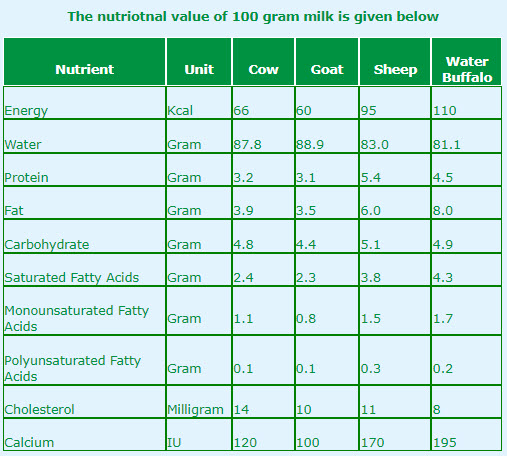Milk Composition
Water:
Water is major constituent of milk as it constitute more than 80% of whole milk. The amount of water in milk is regulated by the amount of lactose synthesized by the secretary cells of the mammary gland. The water that goes into the milk is delivered to the mammary gland by the blood. Milk production is very rapidly affected by a shortage of water and drops the same day drinking water is limited or unavailable. This is one reason why the cow should have free access to a plentiful supply of drinking water at all times.
 |
| Normal composition of pure milk |
Carbohydrates;
The principal carbohydrate in milk is lactose. The concentration of lactose in the milk is relatively constant and averages about 5% (4.8-5.2%). As opposed to the concentration of fat in milk, lactose concentration is similar in all dairy breeds and cannot be altered easily by feeding practices.
Proteins:
Milk protein is very exclusive in nature and it is the natural source of amino acids. More than 95 amino acids of total declared amino acids are available in the milk protein. Milk protein is regarded as high resource and matchless resource of amino acids. Particularly it contains many essentials amino acids which are not synthesized in our body and required for normal metabolism. The concentration of protein in milk varies from 3.0 to 4.0%. The percentage varies with the breed of the cow and in proportion to the amount of fat in the milk. There is a close relationship between the amount of fat and the amount of protein in milk—the higher the fat, the higher the protein. The protein falls into two major groups: caseins (80%) and whey proteins (20%). Casein is always present in the form of calcium caseinate. It is present in the suspicion / colloidal form in the milk.
Fat:
Normally, fat (or lipid) makes up from 3.5 to 6.0% of milk, varying between breeds of cattle and with feeding practices. A ration too rich in concentrates that do not elicit rumination in the cow may result in milk with a depressed percentage of fat (2.0 to 2.5%).
Fat is present in milk in small globules suspended in water. Each globule is surrounded by a layer of phospholipids, which prevents the globules from clumping together by repelling other fat globules and attracting water. As long as this structure is intact, the milk fat remains as an emulsion.
The majority of milk fat is in the form of triglycerides formed by the linking of glycerol and fatty acids. The proportions of fatty acids of different lengths determine the melting point of fat and thus the consistency of the butter derived from it. Milk fat contains predominantly short-chain fatty acids (chains of less than eight carbon atoms) built from acetic acid units derived from fermentation in the rumen. This is a unique feature of milk fat compared with other kinds of animal and plant fats. The long chain fatty acids in milk are primarily the unsaturated acids, with the predominant one being oleic (18-carbon chain), and polyunsaturated linoleic and linolenic acids.
Minerals and Vitamins:
Milk is an excellent source of most minerals and vitamins required for the growth of the young. Differnet minerals found in milk are potassium, calcium, chloride, phosphorus, sodium, sulfur, magensium and small amounts of trace minerals. The digestibility of calcium and phosphorus are unusually high, in part because they are found in association with the casein of the milk. Vitamin A, D, E, K, C and B complex are also found in milk
Factors Affecting composition of milk
The milk composition depends on the various factors; it may vary from:
- Animal to animal
- Breed to breed of same specie
- Season to season: Seasonal variation is very important. In winter, milk is usually high in nitrogenous contents and in summer season, it is high is chloride contents.
- Milking to milking and lactation to lactation
- Availability of feed to the animal
Numerical values of various components of milk for different species are as follows (These values vary with breed to breed):
 |
| Milk composition in different species |
Nutritional value of Milk:
Here's nutritive value of pure milk:
 |
| Nutritional value of Milk |
Tags:
Dairy Technology
